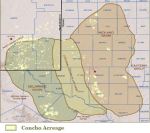Concho Resources (NYSE: CXO) announced in a press release on May 13, 2012, that it entered an agreement to buy all of Three Rivers Operating Company’s oil and gas assets (all of Three Rivers’ assets are located in the Permian Basin) for $1 billion in an all cash deal effective April 1, 2012. Concho Resources, a pure-play Permian Basin operator with one of the largest acreage positions in the Basin, just strengthened its position by purchasing 200k net acres, proved reserves of 58 MMBOE (50% oil) and average production of 7.0 MBOEPD. This brings the company’s pro-forma acreage and proved reserve totals in the Permian Basin to approximately 750k and 445 MMBOE, respectively.
The Permian Basin: When someone refers to the Permian (see maps below), they may be referring to one or all of three distinct basins within the Permian Basin: the Delaware (West Texas/East New Mexico), Central (West Texas) and the Midland (West Texas) Basins. When looking for comparable transactions which I discuss below, it’s best to find a transaction that’s located in the Basin from which your target deal is located in and even better yet, in the same county(s). Note via the Three Rivers map below that the acquisition spanned the entire Permian Basin, so any Permian comparable transaction will be helpful.
Source: Concho’s May, 2012 investor presentation, Three Rivers’ Corporate Website
Valuation: CXO purchased Three Rivers’ assets for $5,000 per acre / $17.24 per proved BOE / $142,857 per flowing BOEPD (production).
Did CXO overpay/underpay for the assets? This is important if we are an investor in CXO, because it can tell us how responsible the company is investing shareholder dollars. To determine this, we need to find some comparable transactions in the Permian Basin which are preferably recent. The best place to find this data is to subscribe to a database such as Derrick Petroleum Services’ E&P Transactions database. Because these subscriptions can be quite costly for the average investor, your best bet is to use Google, Derrick Petroleum’s free database and/or monitor press releases from other Permian players.
February 10, 2012: Energen (NYSE: EGN) purchased Permian assets in the Midland Basin for $65.8 million from an undisclosed seller. The assets acquired included 3,200 net acres and proved plus probable (2P) reserves totaling 8.5 MMBOE (80% proved undeveloped). LPI purchased the assets for $20,563 per acre and $7.74 per 2P BOE reserves (no production figures were given). Generally speaking, the odds of recovering proved reserves are 90% and the odds of recovering probable reserves are 50%, thus a company would obviously pay less for probable reserves (the press release did note that the reserves were primarily proved).
Analysis: EGN paid over 4x as much per acre as CXO paid, but it appears it paid less for proved reserves; however it’s difficult to be sure considering EGN’s package included at least some probable reserves. These reserves are located in the Wolfberry trend (Midland Basin) where companies like Approach Resources (NASDAQ: AREX) had terrific success during 2011.
July 6, 2011: Laredo Petroleum (NYSE: LPI) acquired Broad Oak Energy (private) for $1 billion. Broad Oak was a pure-play Permian company with assets primarily in Reagan and Glasscock Counties of the Midland Basin. The assets acquired included 338k net acres, proved reserves of 140 MMBOE (35% oil) and average production of 21.7 MBOEPD. LPI purchased the assets for $2,959 per acre, $7.14 per proved BOE and $46,154 per flowing BOEPD.
Analysis: While LPI paid significantly less than CXO with respect to all metrics, keep in mind that Broad Oak’s reserves are gassier than Three Rivers’ (35% versus 50%, respectively). We also know from CXO’s press release on the acquisition that the acquired assets are 55% proved developed, essentially meaning wells have been drilled on 55% of the proved reserves. All things equal, a company would pay more for developed acreage, however it’s difficult to draw a conclusion because we don’t know how developed Broad Oak’s acreage was.
Putting it all together: While CXO paid a premium for reserves and production, the acreage value seems very reasonable. I would also question whether they even paid a premium for reserves and production, being as their reserves were oily. If we compare the value CXO paid for reserves ($17.24 per proved BOE) and production ($142,857 per flowing BOEPD) to what the market values CXO’s reserves on an EV/Proved Reserves basis ($29.96 per BOE) and EV/Production ($161,256), we find that CXO added assets which complement their asset base (see maps above) for significantly less than the market is valuing its own assets pre-acquisition.



Pingback: Noble Nets $320 Million in Sale of Non-core Assets in Permian « theenergyharbinger